Project Management: Duration, Critical Path, and Changes
VerifiedAdded on 2022/08/11
|11
|1949
|19
Project
AI Summary
This project management assignment analyzes various aspects of project execution. It begins by calculating expected durations and standard deviations for different activities, followed by identifying the critical path and calculating the project completion time. The analysis includes a detailed table of early start, early finish, late start, late finish, and slack for each activity. Furthermore, the document explores the probability of project completion within a specific timeframe, delving into the process of requirement gathering, outlining key activities, and emphasizing the importance of stakeholder management. The assignment also discusses potential factors that can impact project schedules, such as changes in stakeholders, regulatory adjustments, and technological updates. It then provides a structured approach to change management, detailing steps for determining scope, incorporating changes, and obtaining project approval. Finally, the document concludes by highlighting the significance of change management and exploring various project management techniques like classic, waterfall, and agile methodologies. References are provided to support the analysis.
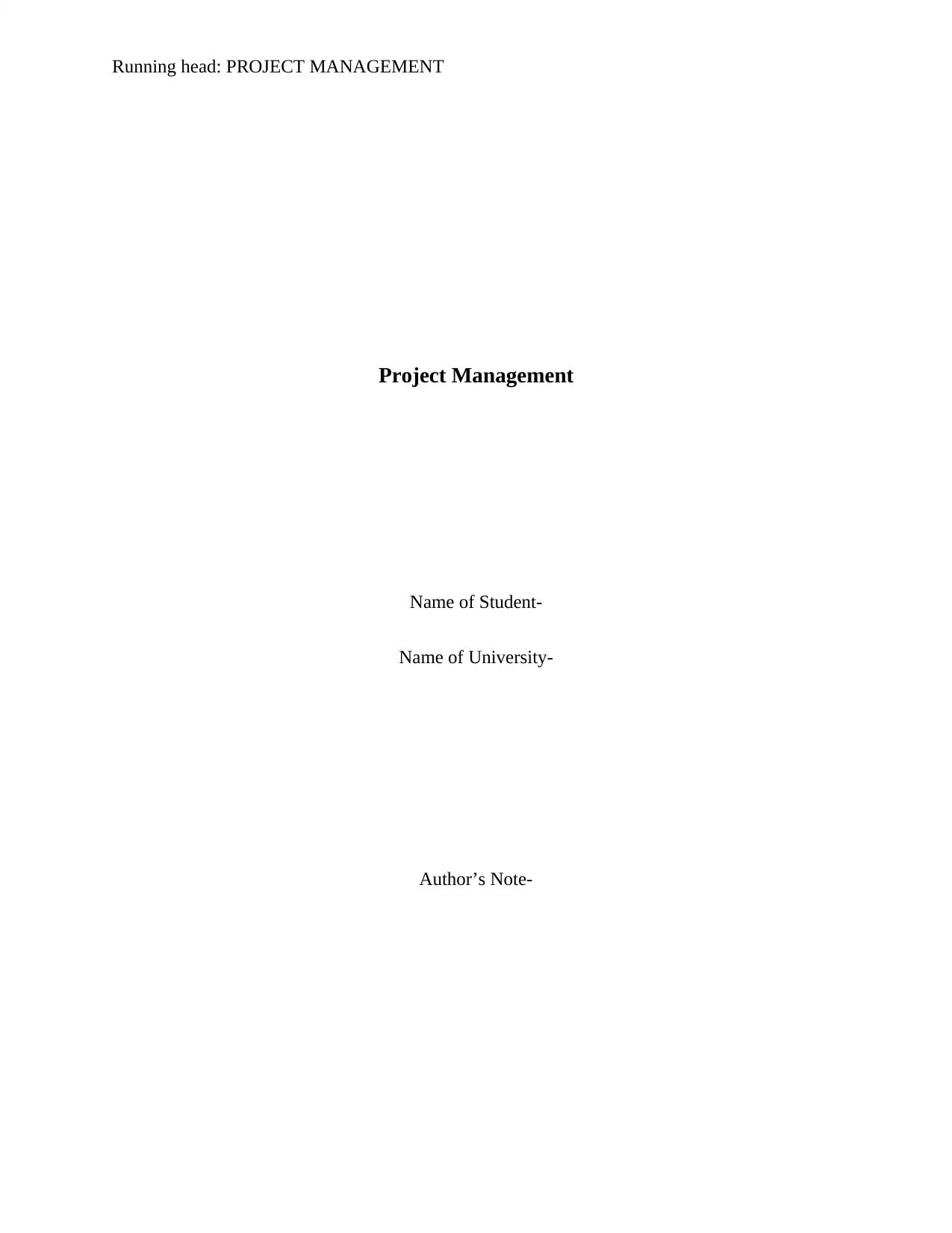
Running head: PROJECT MANAGEMENT
Project Management
Name of Student-
Name of University-
Author’s Note-
Project Management
Name of Student-
Name of University-
Author’s Note-
Paraphrase This Document
Need a fresh take? Get an instant paraphrase of this document with our AI Paraphraser
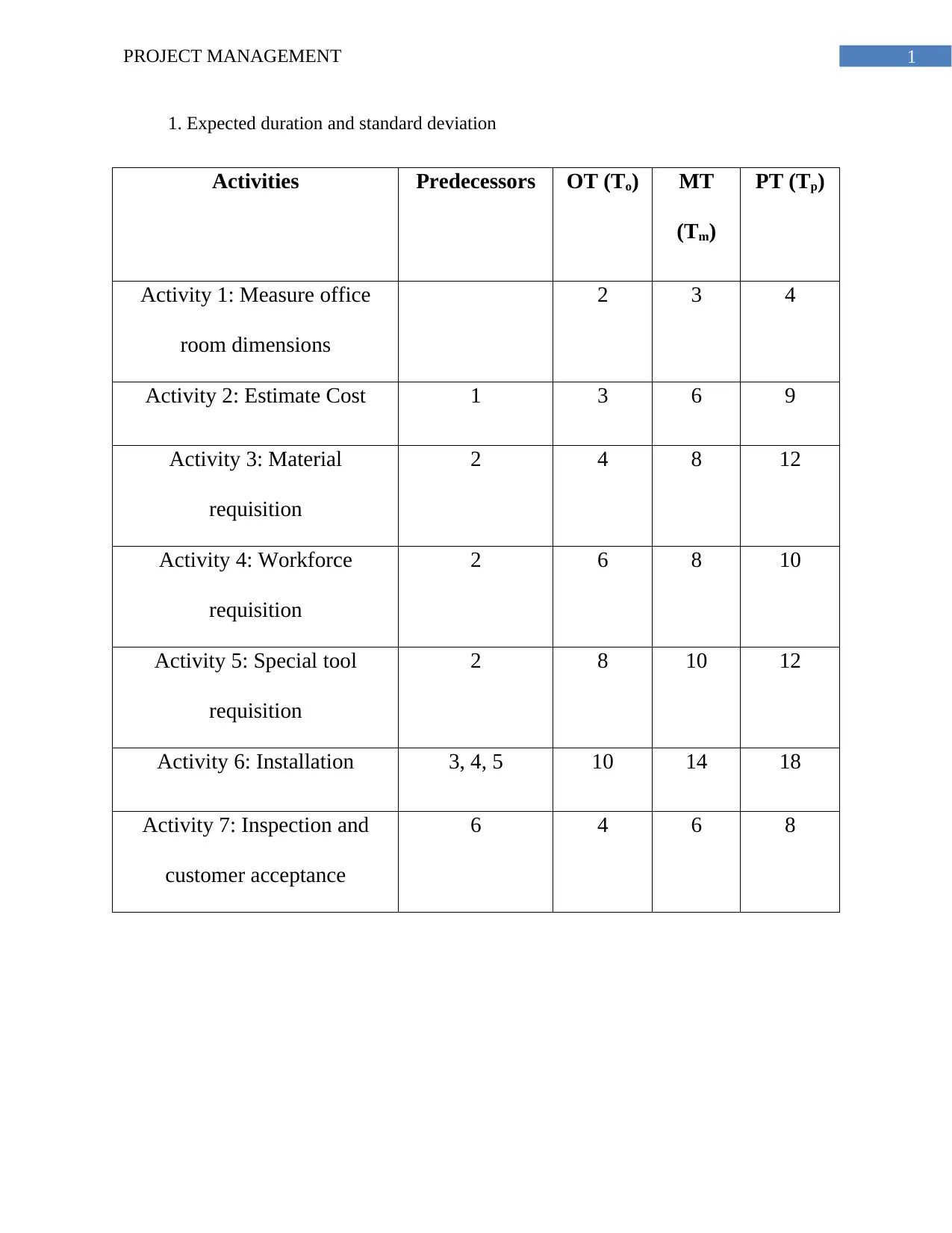
1PROJECT MANAGEMENT
1. Expected duration and standard deviation
Activities Predecessors OT (To) MT
(Tm)
PT (Tp)
Activity 1: Measure office
room dimensions
2 3 4
Activity 2: Estimate Cost 1 3 6 9
Activity 3: Material
requisition
2 4 8 12
Activity 4: Workforce
requisition
2 6 8 10
Activity 5: Special tool
requisition
2 8 10 12
Activity 6: Installation 3, 4, 5 10 14 18
Activity 7: Inspection and
customer acceptance
6 4 6 8
1. Expected duration and standard deviation
Activities Predecessors OT (To) MT
(Tm)
PT (Tp)
Activity 1: Measure office
room dimensions
2 3 4
Activity 2: Estimate Cost 1 3 6 9
Activity 3: Material
requisition
2 4 8 12
Activity 4: Workforce
requisition
2 6 8 10
Activity 5: Special tool
requisition
2 8 10 12
Activity 6: Installation 3, 4, 5 10 14 18
Activity 7: Inspection and
customer acceptance
6 4 6 8
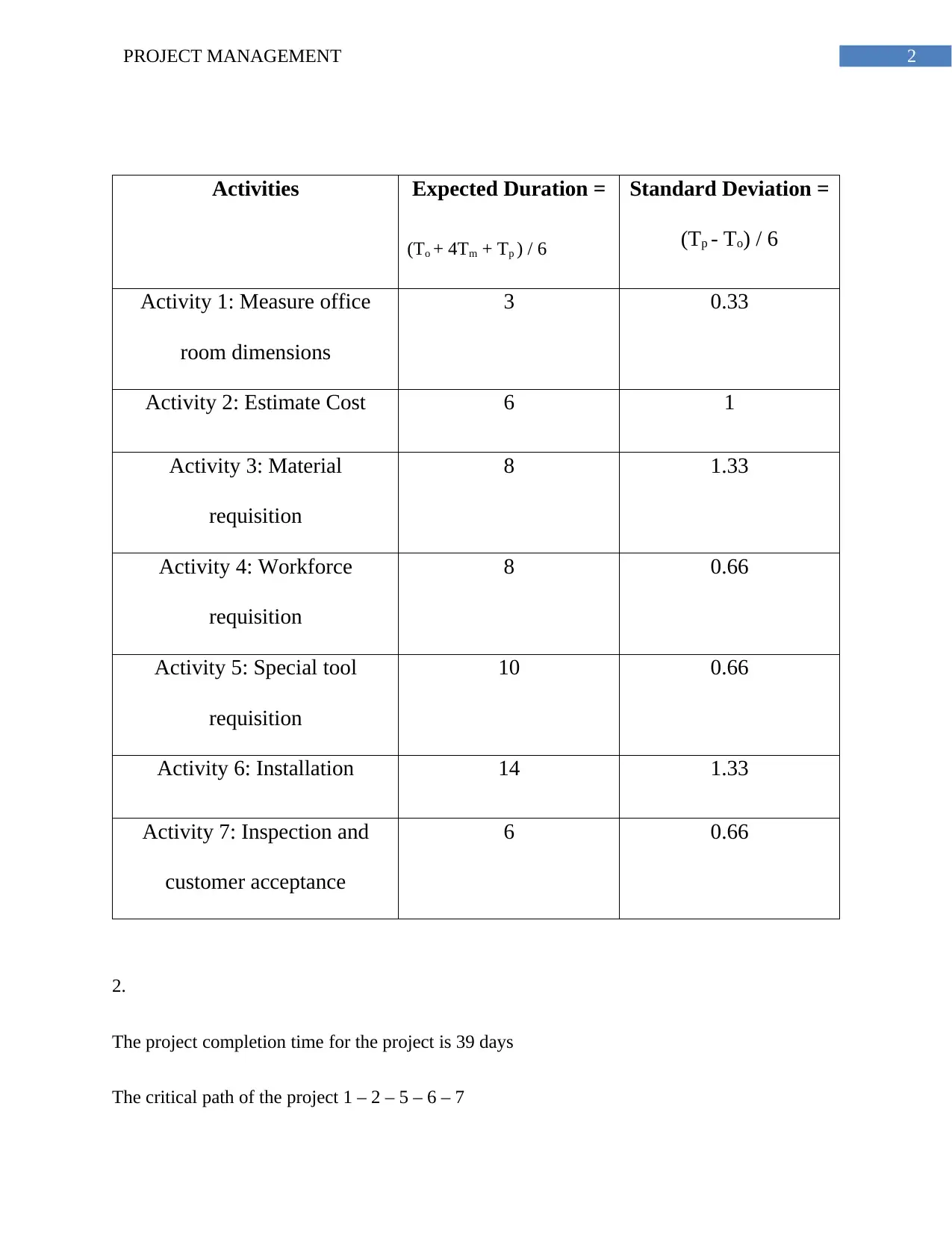
2PROJECT MANAGEMENT
Activities Expected Duration =
(To + 4Tm + Tp ) / 6
Standard Deviation =
(Tp - To) / 6
Activity 1: Measure office
room dimensions
3 0.33
Activity 2: Estimate Cost 6 1
Activity 3: Material
requisition
8 1.33
Activity 4: Workforce
requisition
8 0.66
Activity 5: Special tool
requisition
10 0.66
Activity 6: Installation 14 1.33
Activity 7: Inspection and
customer acceptance
6 0.66
2.
The project completion time for the project is 39 days
The critical path of the project 1 – 2 – 5 – 6 – 7
Activities Expected Duration =
(To + 4Tm + Tp ) / 6
Standard Deviation =
(Tp - To) / 6
Activity 1: Measure office
room dimensions
3 0.33
Activity 2: Estimate Cost 6 1
Activity 3: Material
requisition
8 1.33
Activity 4: Workforce
requisition
8 0.66
Activity 5: Special tool
requisition
10 0.66
Activity 6: Installation 14 1.33
Activity 7: Inspection and
customer acceptance
6 0.66
2.
The project completion time for the project is 39 days
The critical path of the project 1 – 2 – 5 – 6 – 7
⊘ This is a preview!⊘
Do you want full access?
Subscribe today to unlock all pages.

Trusted by 1+ million students worldwide
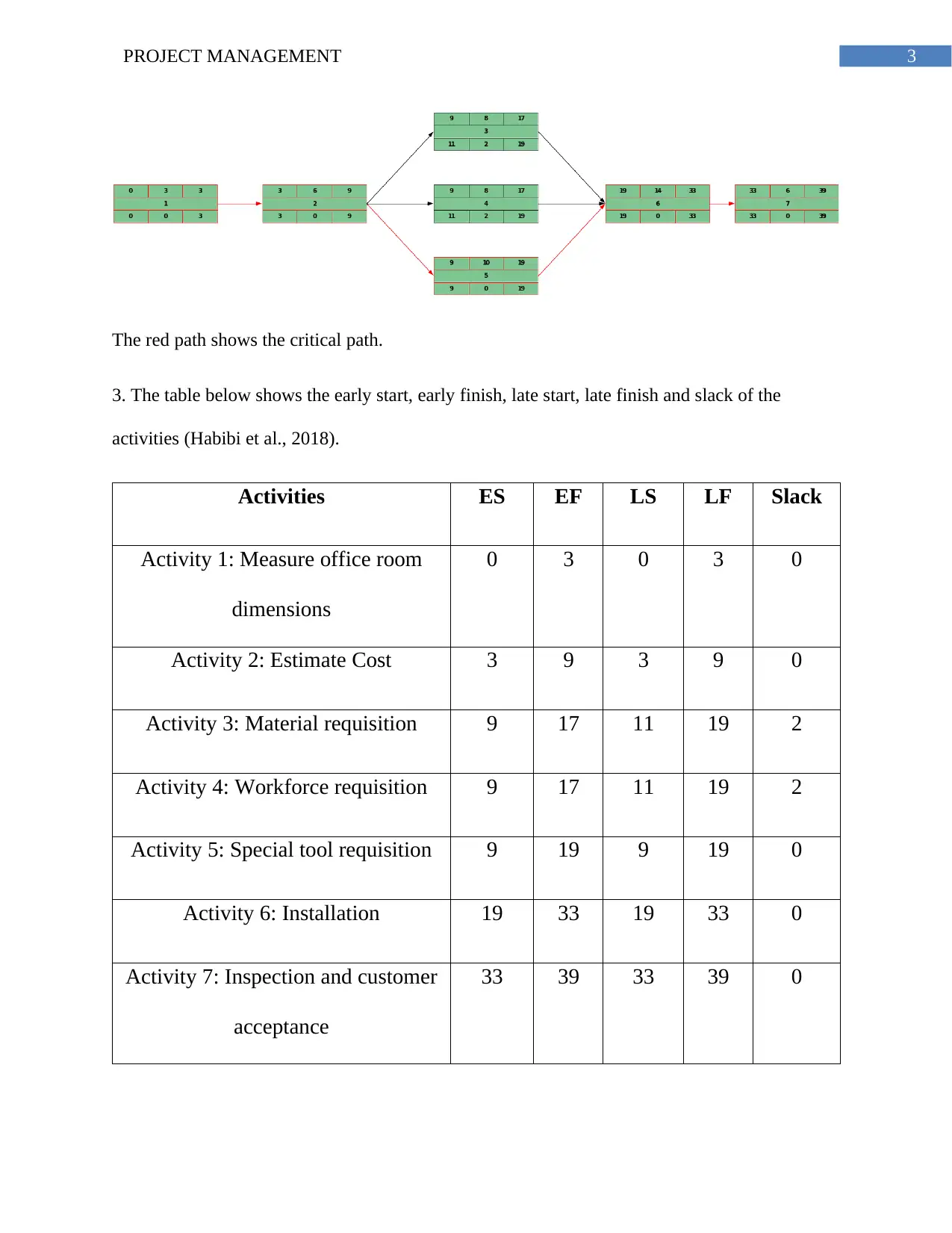
3PROJECT MANAGEMENT
The red path shows the critical path.
3. The table below shows the early start, early finish, late start, late finish and slack of the
activities (Habibi et al., 2018).
Activities ES EF LS LF Slack
Activity 1: Measure office room
dimensions
0 3 0 3 0
Activity 2: Estimate Cost 3 9 3 9 0
Activity 3: Material requisition 9 17 11 19 2
Activity 4: Workforce requisition 9 17 11 19 2
Activity 5: Special tool requisition 9 19 9 19 0
Activity 6: Installation 19 33 19 33 0
Activity 7: Inspection and customer
acceptance
33 39 33 39 0
The red path shows the critical path.
3. The table below shows the early start, early finish, late start, late finish and slack of the
activities (Habibi et al., 2018).
Activities ES EF LS LF Slack
Activity 1: Measure office room
dimensions
0 3 0 3 0
Activity 2: Estimate Cost 3 9 3 9 0
Activity 3: Material requisition 9 17 11 19 2
Activity 4: Workforce requisition 9 17 11 19 2
Activity 5: Special tool requisition 9 19 9 19 0
Activity 6: Installation 19 33 19 33 0
Activity 7: Inspection and customer
acceptance
33 39 33 39 0
Paraphrase This Document
Need a fresh take? Get an instant paraphrase of this document with our AI Paraphraser
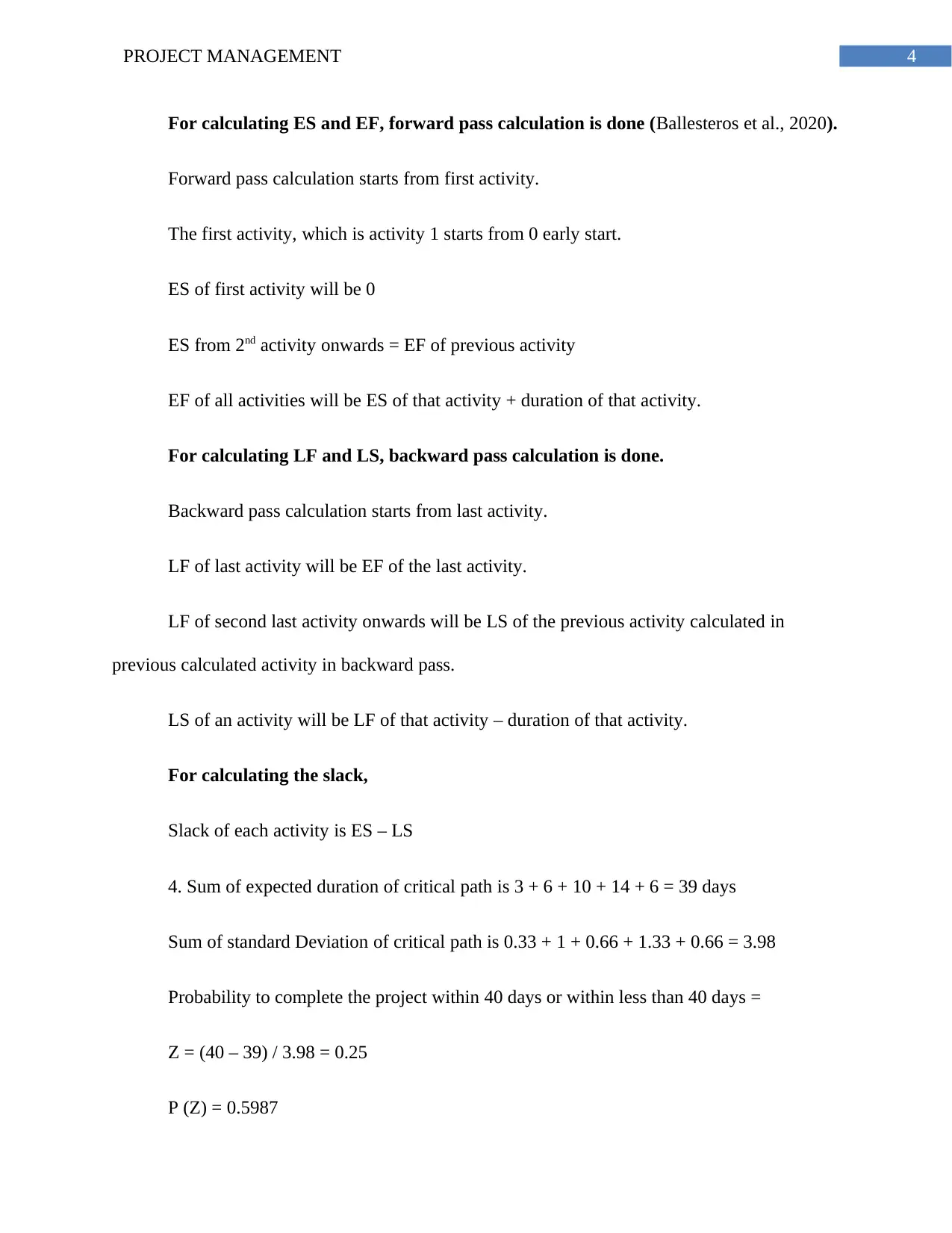
4PROJECT MANAGEMENT
For calculating ES and EF, forward pass calculation is done (Ballesteros et al., 2020).
Forward pass calculation starts from first activity.
The first activity, which is activity 1 starts from 0 early start.
ES of first activity will be 0
ES from 2nd activity onwards = EF of previous activity
EF of all activities will be ES of that activity + duration of that activity.
For calculating LF and LS, backward pass calculation is done.
Backward pass calculation starts from last activity.
LF of last activity will be EF of the last activity.
LF of second last activity onwards will be LS of the previous activity calculated in
previous calculated activity in backward pass.
LS of an activity will be LF of that activity – duration of that activity.
For calculating the slack,
Slack of each activity is ES – LS
4. Sum of expected duration of critical path is 3 + 6 + 10 + 14 + 6 = 39 days
Sum of standard Deviation of critical path is 0.33 + 1 + 0.66 + 1.33 + 0.66 = 3.98
Probability to complete the project within 40 days or within less than 40 days =
Z = (40 – 39) / 3.98 = 0.25
P (Z) = 0.5987
For calculating ES and EF, forward pass calculation is done (Ballesteros et al., 2020).
Forward pass calculation starts from first activity.
The first activity, which is activity 1 starts from 0 early start.
ES of first activity will be 0
ES from 2nd activity onwards = EF of previous activity
EF of all activities will be ES of that activity + duration of that activity.
For calculating LF and LS, backward pass calculation is done.
Backward pass calculation starts from last activity.
LF of last activity will be EF of the last activity.
LF of second last activity onwards will be LS of the previous activity calculated in
previous calculated activity in backward pass.
LS of an activity will be LF of that activity – duration of that activity.
For calculating the slack,
Slack of each activity is ES – LS
4. Sum of expected duration of critical path is 3 + 6 + 10 + 14 + 6 = 39 days
Sum of standard Deviation of critical path is 0.33 + 1 + 0.66 + 1.33 + 0.66 = 3.98
Probability to complete the project within 40 days or within less than 40 days =
Z = (40 – 39) / 3.98 = 0.25
P (Z) = 0.5987
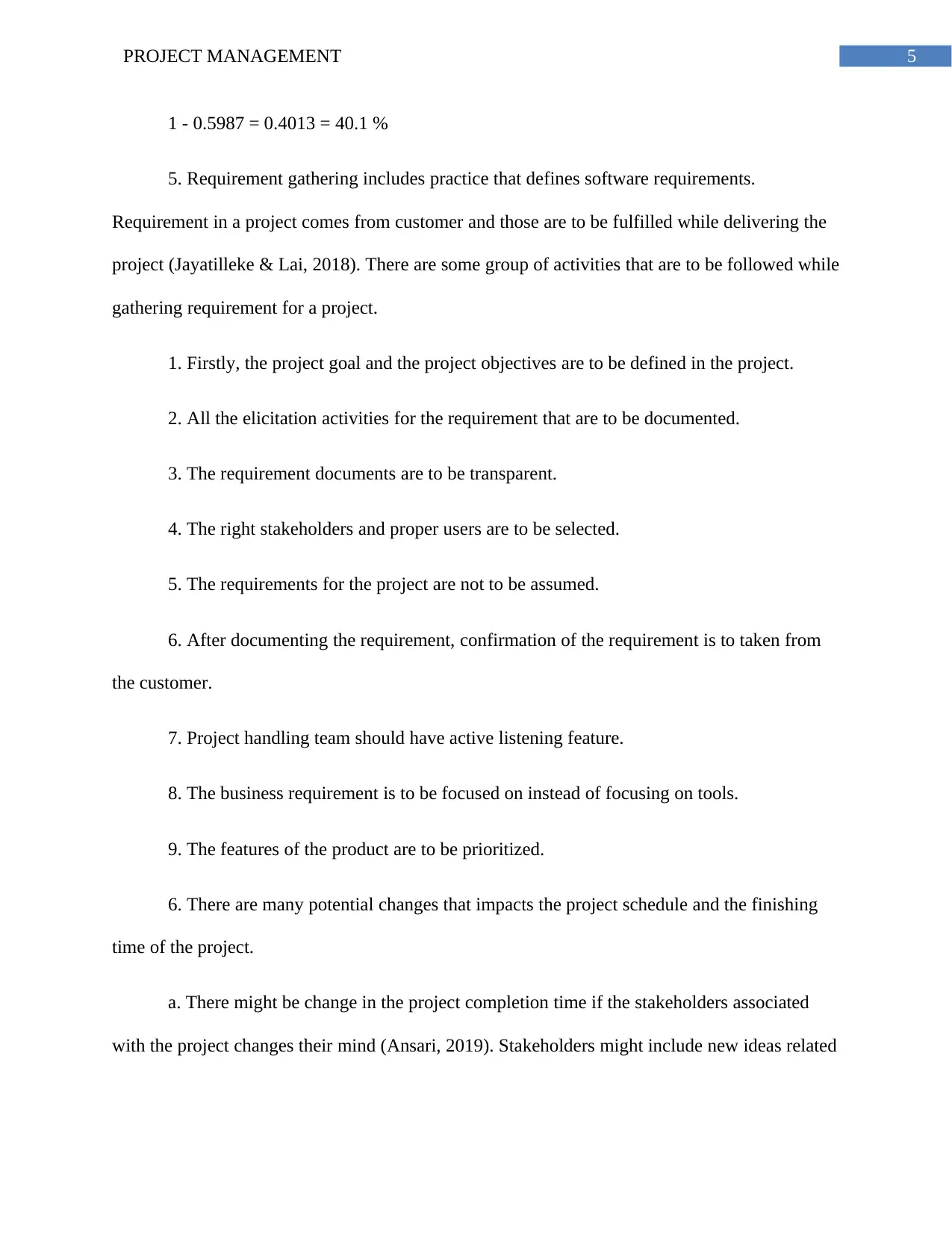
5PROJECT MANAGEMENT
1 - 0.5987 = 0.4013 = 40.1 %
5. Requirement gathering includes practice that defines software requirements.
Requirement in a project comes from customer and those are to be fulfilled while delivering the
project (Jayatilleke & Lai, 2018). There are some group of activities that are to be followed while
gathering requirement for a project.
1. Firstly, the project goal and the project objectives are to be defined in the project.
2. All the elicitation activities for the requirement that are to be documented.
3. The requirement documents are to be transparent.
4. The right stakeholders and proper users are to be selected.
5. The requirements for the project are not to be assumed.
6. After documenting the requirement, confirmation of the requirement is to taken from
the customer.
7. Project handling team should have active listening feature.
8. The business requirement is to be focused on instead of focusing on tools.
9. The features of the product are to be prioritized.
6. There are many potential changes that impacts the project schedule and the finishing
time of the project.
a. There might be change in the project completion time if the stakeholders associated
with the project changes their mind (Ansari, 2019). Stakeholders might include new ideas related
1 - 0.5987 = 0.4013 = 40.1 %
5. Requirement gathering includes practice that defines software requirements.
Requirement in a project comes from customer and those are to be fulfilled while delivering the
project (Jayatilleke & Lai, 2018). There are some group of activities that are to be followed while
gathering requirement for a project.
1. Firstly, the project goal and the project objectives are to be defined in the project.
2. All the elicitation activities for the requirement that are to be documented.
3. The requirement documents are to be transparent.
4. The right stakeholders and proper users are to be selected.
5. The requirements for the project are not to be assumed.
6. After documenting the requirement, confirmation of the requirement is to taken from
the customer.
7. Project handling team should have active listening feature.
8. The business requirement is to be focused on instead of focusing on tools.
9. The features of the product are to be prioritized.
6. There are many potential changes that impacts the project schedule and the finishing
time of the project.
a. There might be change in the project completion time if the stakeholders associated
with the project changes their mind (Ansari, 2019). Stakeholders might include new ideas related
⊘ This is a preview!⊘
Do you want full access?
Subscribe today to unlock all pages.

Trusted by 1+ million students worldwide
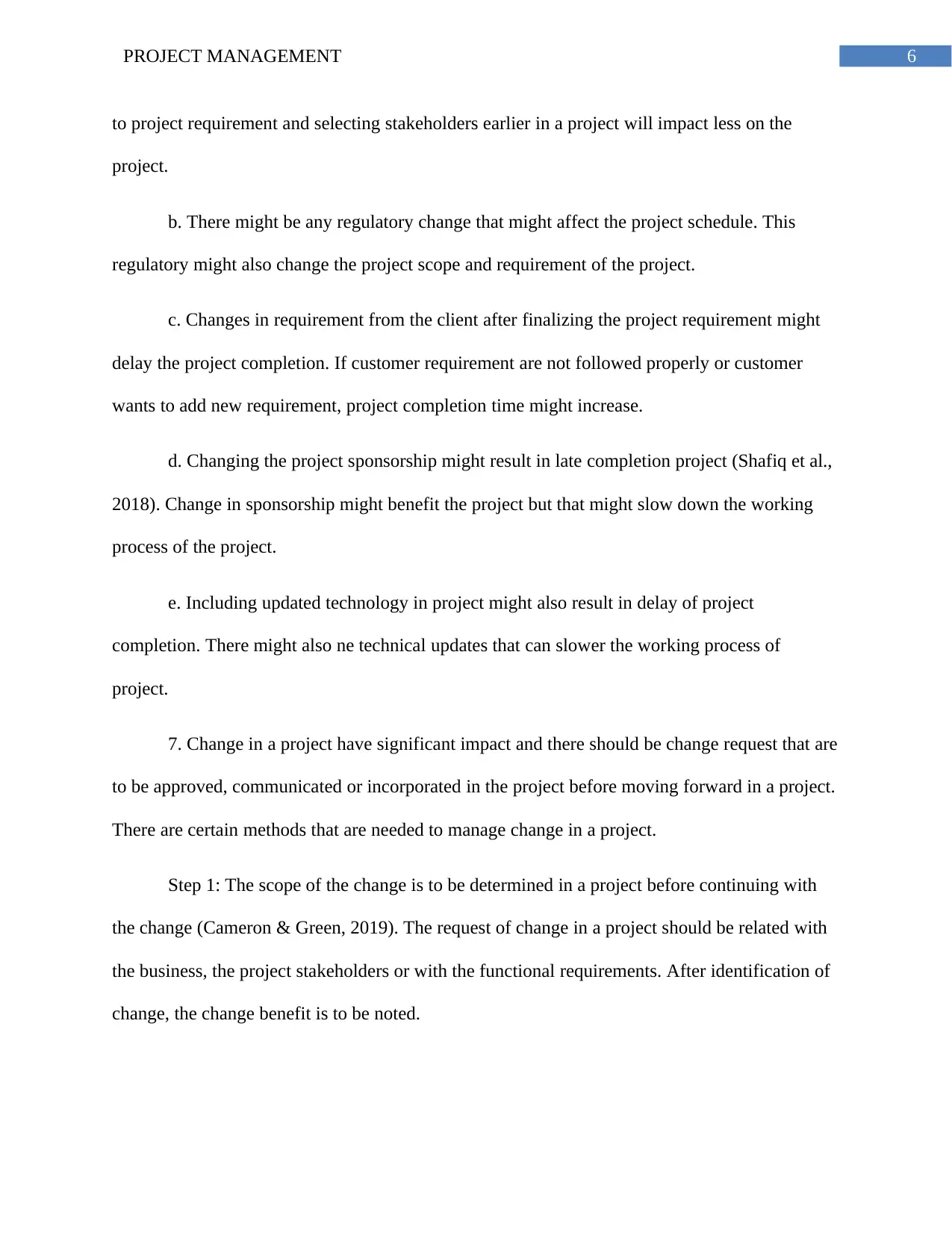
6PROJECT MANAGEMENT
to project requirement and selecting stakeholders earlier in a project will impact less on the
project.
b. There might be any regulatory change that might affect the project schedule. This
regulatory might also change the project scope and requirement of the project.
c. Changes in requirement from the client after finalizing the project requirement might
delay the project completion. If customer requirement are not followed properly or customer
wants to add new requirement, project completion time might increase.
d. Changing the project sponsorship might result in late completion project (Shafiq et al.,
2018). Change in sponsorship might benefit the project but that might slow down the working
process of the project.
e. Including updated technology in project might also result in delay of project
completion. There might also ne technical updates that can slower the working process of
project.
7. Change in a project have significant impact and there should be change request that are
to be approved, communicated or incorporated in the project before moving forward in a project.
There are certain methods that are needed to manage change in a project.
Step 1: The scope of the change is to be determined in a project before continuing with
the change (Cameron & Green, 2019). The request of change in a project should be related with
the business, the project stakeholders or with the functional requirements. After identification of
change, the change benefit is to be noted.
to project requirement and selecting stakeholders earlier in a project will impact less on the
project.
b. There might be any regulatory change that might affect the project schedule. This
regulatory might also change the project scope and requirement of the project.
c. Changes in requirement from the client after finalizing the project requirement might
delay the project completion. If customer requirement are not followed properly or customer
wants to add new requirement, project completion time might increase.
d. Changing the project sponsorship might result in late completion project (Shafiq et al.,
2018). Change in sponsorship might benefit the project but that might slow down the working
process of the project.
e. Including updated technology in project might also result in delay of project
completion. There might also ne technical updates that can slower the working process of
project.
7. Change in a project have significant impact and there should be change request that are
to be approved, communicated or incorporated in the project before moving forward in a project.
There are certain methods that are needed to manage change in a project.
Step 1: The scope of the change is to be determined in a project before continuing with
the change (Cameron & Green, 2019). The request of change in a project should be related with
the business, the project stakeholders or with the functional requirements. After identification of
change, the change benefit is to be noted.
Paraphrase This Document
Need a fresh take? Get an instant paraphrase of this document with our AI Paraphraser
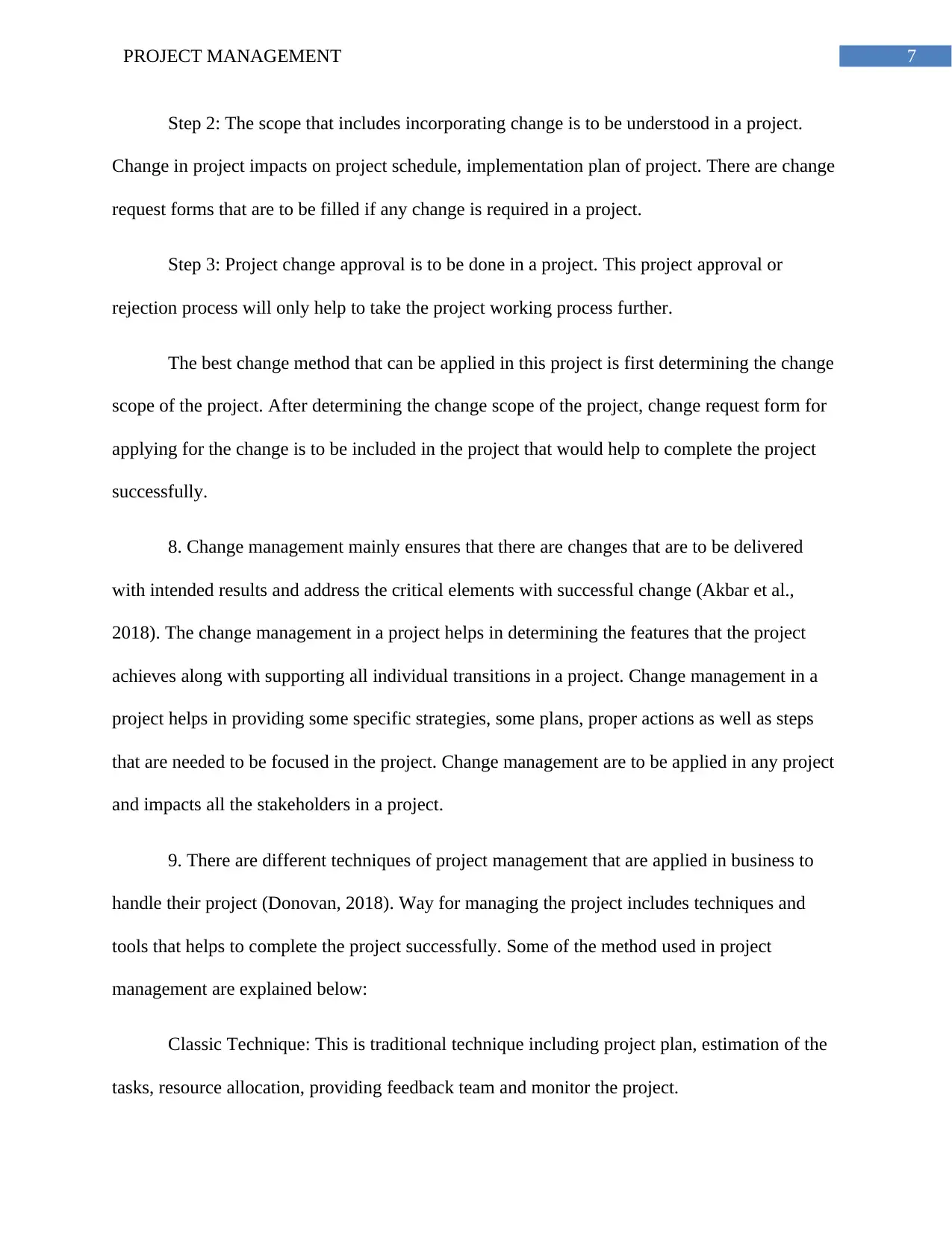
7PROJECT MANAGEMENT
Step 2: The scope that includes incorporating change is to be understood in a project.
Change in project impacts on project schedule, implementation plan of project. There are change
request forms that are to be filled if any change is required in a project.
Step 3: Project change approval is to be done in a project. This project approval or
rejection process will only help to take the project working process further.
The best change method that can be applied in this project is first determining the change
scope of the project. After determining the change scope of the project, change request form for
applying for the change is to be included in the project that would help to complete the project
successfully.
8. Change management mainly ensures that there are changes that are to be delivered
with intended results and address the critical elements with successful change (Akbar et al.,
2018). The change management in a project helps in determining the features that the project
achieves along with supporting all individual transitions in a project. Change management in a
project helps in providing some specific strategies, some plans, proper actions as well as steps
that are needed to be focused in the project. Change management are to be applied in any project
and impacts all the stakeholders in a project.
9. There are different techniques of project management that are applied in business to
handle their project (Donovan, 2018). Way for managing the project includes techniques and
tools that helps to complete the project successfully. Some of the method used in project
management are explained below:
Classic Technique: This is traditional technique including project plan, estimation of the
tasks, resource allocation, providing feedback team and monitor the project.
Step 2: The scope that includes incorporating change is to be understood in a project.
Change in project impacts on project schedule, implementation plan of project. There are change
request forms that are to be filled if any change is required in a project.
Step 3: Project change approval is to be done in a project. This project approval or
rejection process will only help to take the project working process further.
The best change method that can be applied in this project is first determining the change
scope of the project. After determining the change scope of the project, change request form for
applying for the change is to be included in the project that would help to complete the project
successfully.
8. Change management mainly ensures that there are changes that are to be delivered
with intended results and address the critical elements with successful change (Akbar et al.,
2018). The change management in a project helps in determining the features that the project
achieves along with supporting all individual transitions in a project. Change management in a
project helps in providing some specific strategies, some plans, proper actions as well as steps
that are needed to be focused in the project. Change management are to be applied in any project
and impacts all the stakeholders in a project.
9. There are different techniques of project management that are applied in business to
handle their project (Donovan, 2018). Way for managing the project includes techniques and
tools that helps to complete the project successfully. Some of the method used in project
management are explained below:
Classic Technique: This is traditional technique including project plan, estimation of the
tasks, resource allocation, providing feedback team and monitor the project.
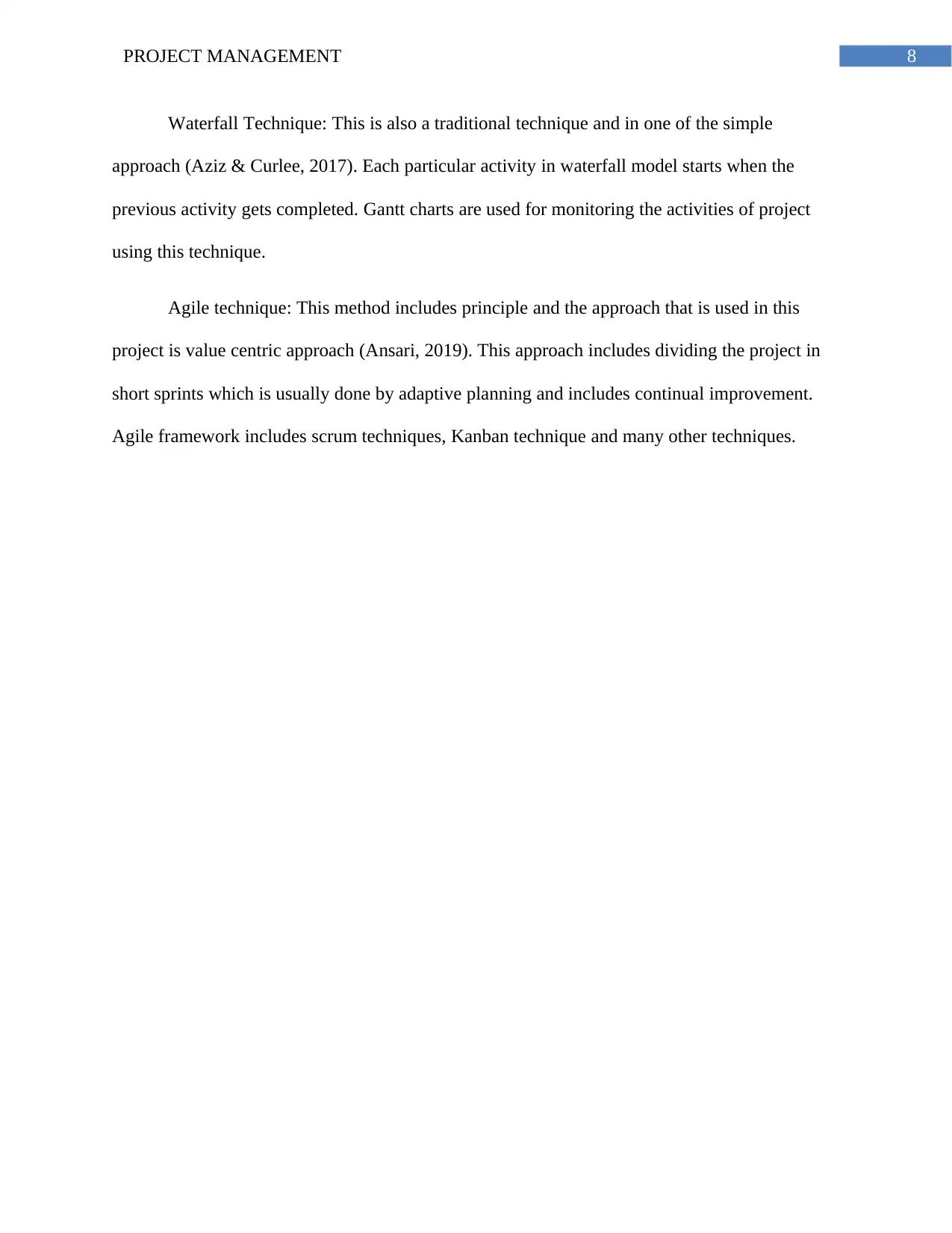
8PROJECT MANAGEMENT
Waterfall Technique: This is also a traditional technique and in one of the simple
approach (Aziz & Curlee, 2017). Each particular activity in waterfall model starts when the
previous activity gets completed. Gantt charts are used for monitoring the activities of project
using this technique.
Agile technique: This method includes principle and the approach that is used in this
project is value centric approach (Ansari, 2019). This approach includes dividing the project in
short sprints which is usually done by adaptive planning and includes continual improvement.
Agile framework includes scrum techniques, Kanban technique and many other techniques.
Waterfall Technique: This is also a traditional technique and in one of the simple
approach (Aziz & Curlee, 2017). Each particular activity in waterfall model starts when the
previous activity gets completed. Gantt charts are used for monitoring the activities of project
using this technique.
Agile technique: This method includes principle and the approach that is used in this
project is value centric approach (Ansari, 2019). This approach includes dividing the project in
short sprints which is usually done by adaptive planning and includes continual improvement.
Agile framework includes scrum techniques, Kanban technique and many other techniques.
⊘ This is a preview!⊘
Do you want full access?
Subscribe today to unlock all pages.

Trusted by 1+ million students worldwide
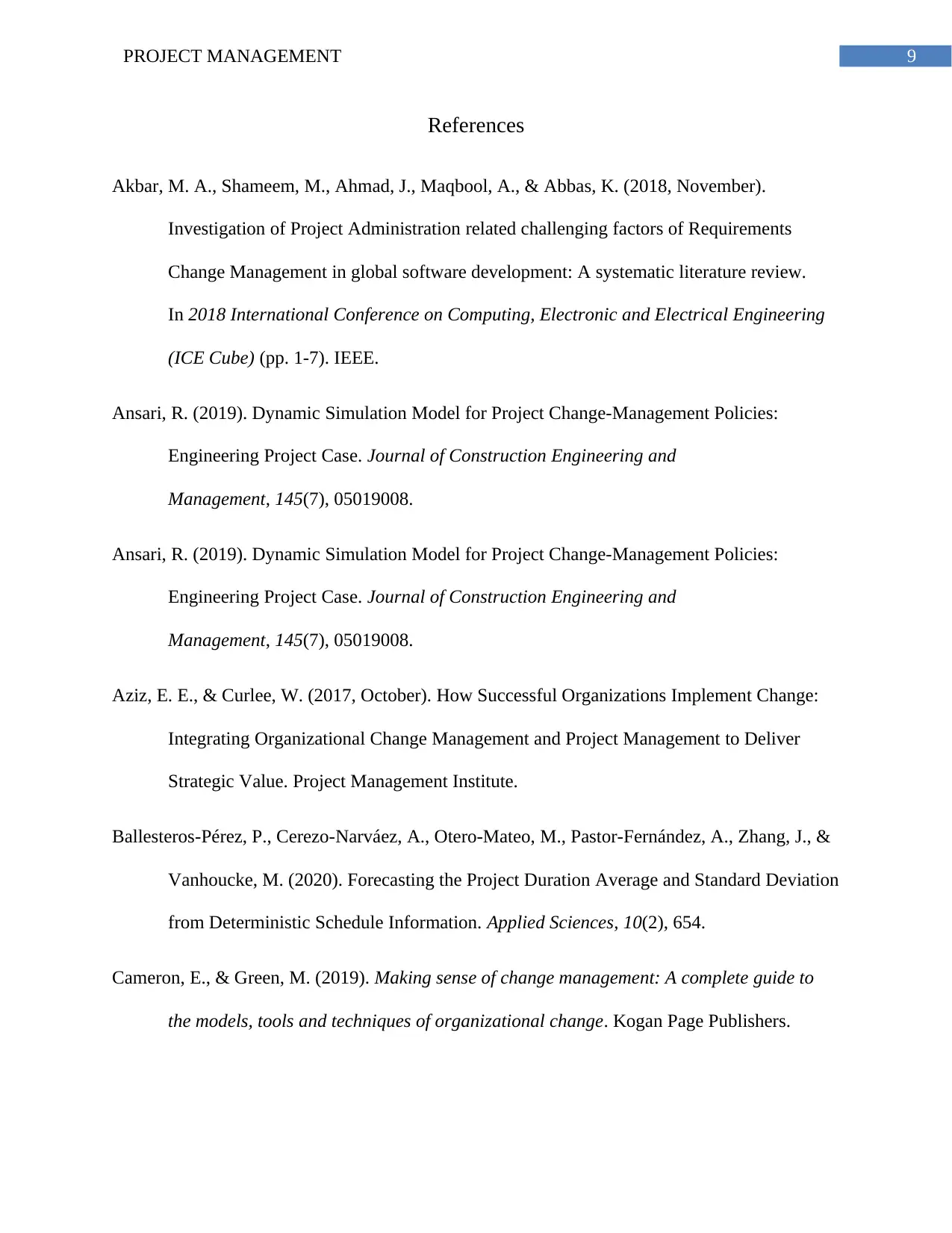
9PROJECT MANAGEMENT
References
Akbar, M. A., Shameem, M., Ahmad, J., Maqbool, A., & Abbas, K. (2018, November).
Investigation of Project Administration related challenging factors of Requirements
Change Management in global software development: A systematic literature review.
In 2018 International Conference on Computing, Electronic and Electrical Engineering
(ICE Cube) (pp. 1-7). IEEE.
Ansari, R. (2019). Dynamic Simulation Model for Project Change-Management Policies:
Engineering Project Case. Journal of Construction Engineering and
Management, 145(7), 05019008.
Ansari, R. (2019). Dynamic Simulation Model for Project Change-Management Policies:
Engineering Project Case. Journal of Construction Engineering and
Management, 145(7), 05019008.
Aziz, E. E., & Curlee, W. (2017, October). How Successful Organizations Implement Change:
Integrating Organizational Change Management and Project Management to Deliver
Strategic Value. Project Management Institute.
Ballesteros-Pérez, P., Cerezo-Narváez, A., Otero-Mateo, M., Pastor-Fernández, A., Zhang, J., &
Vanhoucke, M. (2020). Forecasting the Project Duration Average and Standard Deviation
from Deterministic Schedule Information. Applied Sciences, 10(2), 654.
Cameron, E., & Green, M. (2019). Making sense of change management: A complete guide to
the models, tools and techniques of organizational change. Kogan Page Publishers.
References
Akbar, M. A., Shameem, M., Ahmad, J., Maqbool, A., & Abbas, K. (2018, November).
Investigation of Project Administration related challenging factors of Requirements
Change Management in global software development: A systematic literature review.
In 2018 International Conference on Computing, Electronic and Electrical Engineering
(ICE Cube) (pp. 1-7). IEEE.
Ansari, R. (2019). Dynamic Simulation Model for Project Change-Management Policies:
Engineering Project Case. Journal of Construction Engineering and
Management, 145(7), 05019008.
Ansari, R. (2019). Dynamic Simulation Model for Project Change-Management Policies:
Engineering Project Case. Journal of Construction Engineering and
Management, 145(7), 05019008.
Aziz, E. E., & Curlee, W. (2017, October). How Successful Organizations Implement Change:
Integrating Organizational Change Management and Project Management to Deliver
Strategic Value. Project Management Institute.
Ballesteros-Pérez, P., Cerezo-Narváez, A., Otero-Mateo, M., Pastor-Fernández, A., Zhang, J., &
Vanhoucke, M. (2020). Forecasting the Project Duration Average and Standard Deviation
from Deterministic Schedule Information. Applied Sciences, 10(2), 654.
Cameron, E., & Green, M. (2019). Making sense of change management: A complete guide to
the models, tools and techniques of organizational change. Kogan Page Publishers.
Paraphrase This Document
Need a fresh take? Get an instant paraphrase of this document with our AI Paraphraser
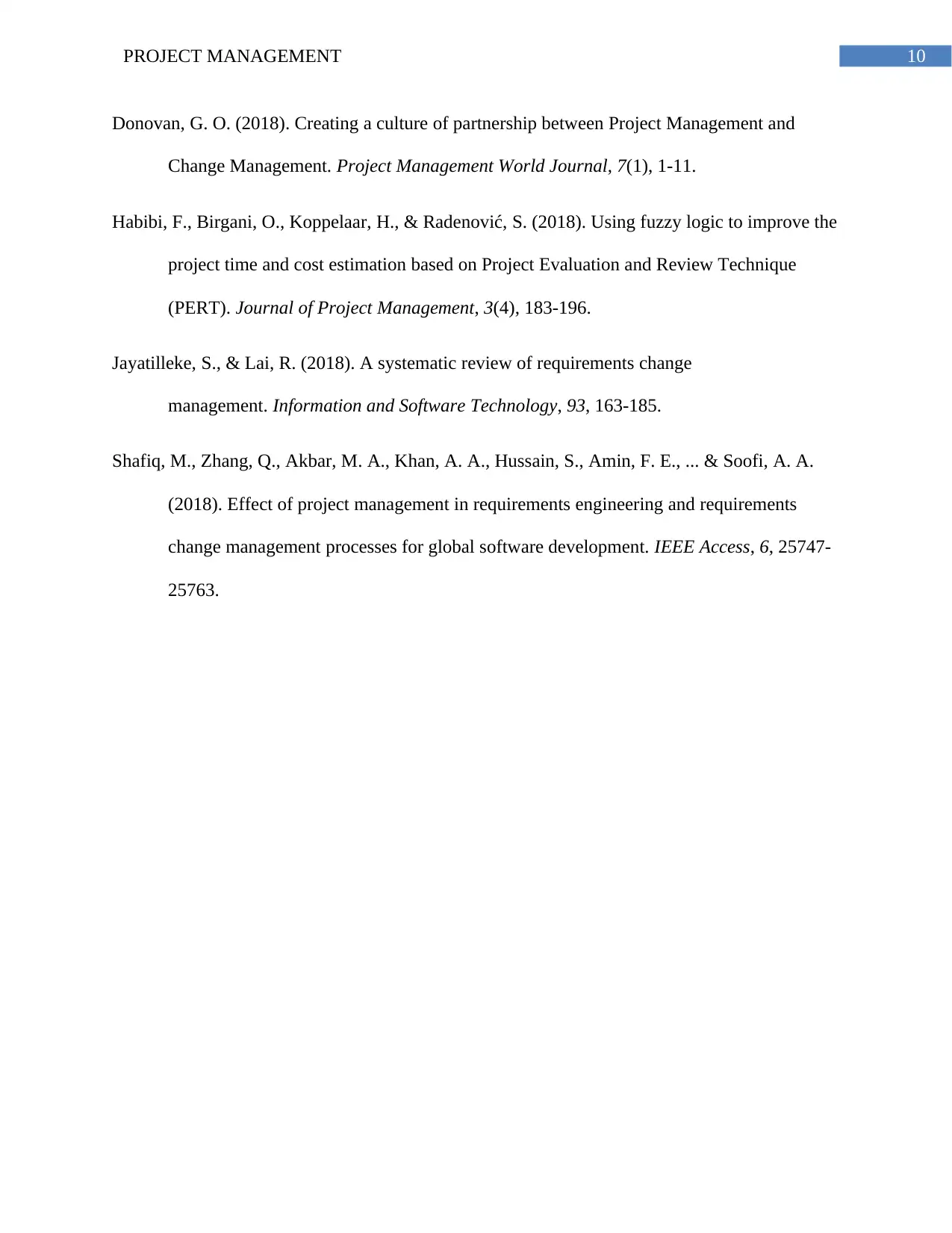
10PROJECT MANAGEMENT
Donovan, G. O. (2018). Creating a culture of partnership between Project Management and
Change Management. Project Management World Journal, 7(1), 1-11.
Habibi, F., Birgani, O., Koppelaar, H., & Radenović, S. (2018). Using fuzzy logic to improve the
project time and cost estimation based on Project Evaluation and Review Technique
(PERT). Journal of Project Management, 3(4), 183-196.
Jayatilleke, S., & Lai, R. (2018). A systematic review of requirements change
management. Information and Software Technology, 93, 163-185.
Shafiq, M., Zhang, Q., Akbar, M. A., Khan, A. A., Hussain, S., Amin, F. E., ... & Soofi, A. A.
(2018). Effect of project management in requirements engineering and requirements
change management processes for global software development. IEEE Access, 6, 25747-
25763.
Donovan, G. O. (2018). Creating a culture of partnership between Project Management and
Change Management. Project Management World Journal, 7(1), 1-11.
Habibi, F., Birgani, O., Koppelaar, H., & Radenović, S. (2018). Using fuzzy logic to improve the
project time and cost estimation based on Project Evaluation and Review Technique
(PERT). Journal of Project Management, 3(4), 183-196.
Jayatilleke, S., & Lai, R. (2018). A systematic review of requirements change
management. Information and Software Technology, 93, 163-185.
Shafiq, M., Zhang, Q., Akbar, M. A., Khan, A. A., Hussain, S., Amin, F. E., ... & Soofi, A. A.
(2018). Effect of project management in requirements engineering and requirements
change management processes for global software development. IEEE Access, 6, 25747-
25763.
1 out of 11
Related Documents
Your All-in-One AI-Powered Toolkit for Academic Success.
+13062052269
info@desklib.com
Available 24*7 on WhatsApp / Email
![[object Object]](/_next/static/media/star-bottom.7253800d.svg)
Unlock your academic potential
Copyright © 2020–2025 A2Z Services. All Rights Reserved. Developed and managed by ZUCOL.




